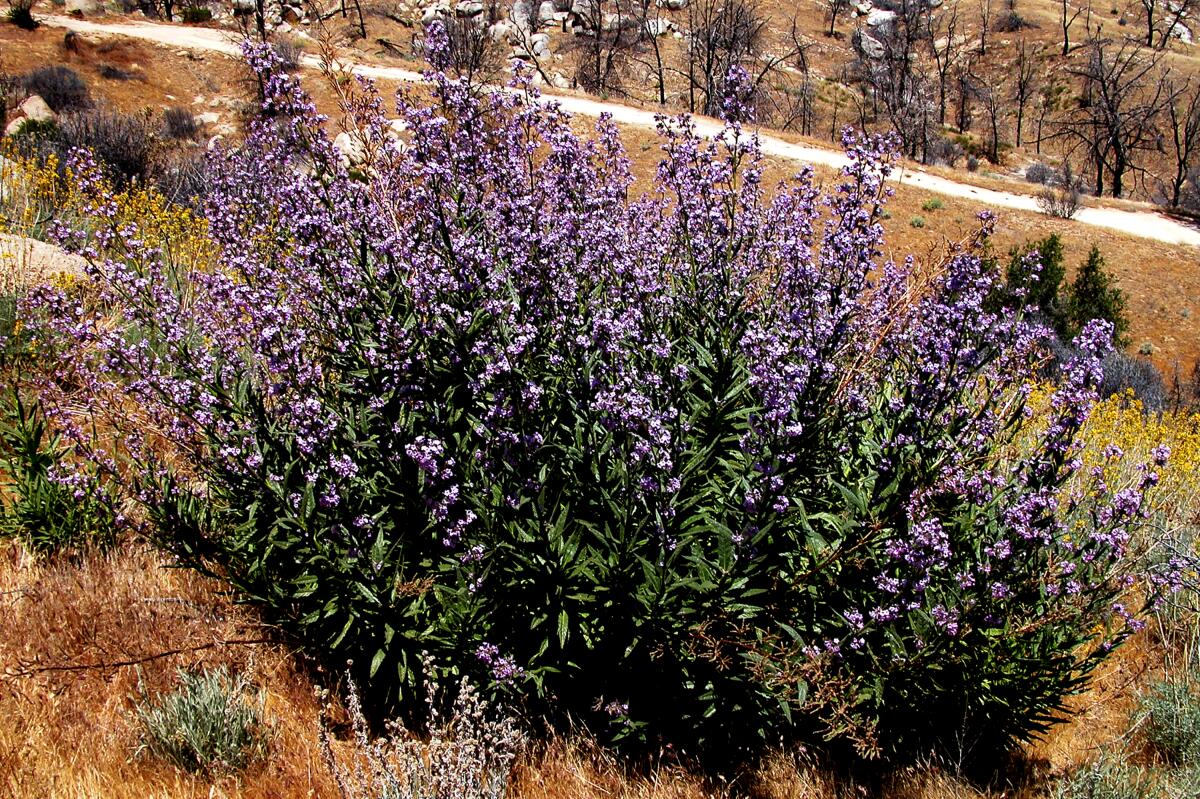Hikers beware: A rash-causing plant is growing in fire-scarred Angeles National Forest

- Share via
- Poodle-dog bush, a pretty but dangerous plant, is growing in parts of the Angeles National Forest hit by recent wildfires.
- Hairs covering the stems, leaves and flowers have glands that secrete a sticky substance that can cause an itchy rash.
A beautiful menace is growing on the freshly charred slopes of the San Gabriel Mountains.
The whimsically named poodle-dog bush thrives in the wake of fires, such as the more than 14,000-acre Eaton fire that ravaged swaths of the Angeles National Forest in January. The mountain shrub strikes the senses with bell-shaped purple flowers and a fragrance that mimics marijuana. But the pretty pup packs a bite. Contact often results in a gnarly skin rash.
Plant experts say conditions have paved the way for a new crop of Eriodictyon parryi in the Angeles National Forest — one that could potentially blanket thousands of acres etched with popular recreation trails for a decade to come. It’s a bane of hikers, but botanists say the native plant plays an important role in the ecosystem.
Cameron Hummels, a veteran San Gabriel Mountains runner and hiker, can clearly point to his worst battle with the bush.
In 2020, the Pasadena resident was trekking in deep snow up to the summit of Mt. Wilson — decked out in shorts and unaware that poodle-dog was buried beneath the icy blanket. Two days later the reaction arrived: redness, itching, oozing, crusting and small, fluid-filled blisters up and down his legs.
“My legs were on fire with itch,” he said. It lasted for weeks.
Poodle-dog isn’t a household name like poison oak and ivy, likely due to its limited geographic region and fleeting nature. The shrub — reportedly named for leaves that can droop and coil like poodle fur — primarily grows in Southern California in chaparral between roughly 3,300 to 7,500 feet, on granitic slopes and ridges. Its seeds can lay dormant for years until intense heat and other cues from a wildfire triggers germination. (Another disturbance, such as a landslide, can also get it going.)
The plant can grow rapidly in the denuded landscape, sometimes shooting up to its maximum height of nearly 10 feet within a year. Over roughly 10 years, other plants outcompete it and it fades away.
Areas the plant inhabits saw plenty of flames in recent months to awaken the sleeping dog in swaths of Southern California.
Not long after the deadly Eaton fire ignited, the Hughes fire sparked near Castaic Lake and chewed through more than 10,000 acres. In September, the Bridge fire that began in the Angeles National Forest devoured more than 50,000 acres. That month, to the east of Los Angeles, the nearly 44,000-acre Line fire ignited near the community of Highland before surging into the San Bernardino National Forest. Several other smaller fires burned in the region between last summer and this spring.
Poodle-dog sprang up quickly in some areas seared by the Bridge fire, according to Esther Lewis, a botanist with the U.S. Forest Service.
With showy, lavender-colored flowers and a general “quirky, Dr. Seuss-type look,” as Lewis put it in an email, hikers might be tempted to pose next to it. But an encounter can be miserable.
While some people don’t react at all, others experience severe skin irritation. The culprit? Hairs covering the stems, leaves and flowers have glands that secrete a sticky substance containing prenylated phenols, which cause an itchy rash, according to Lewis. The reaction is often likened to the reaction to poison oak and ivy, though some say it’s worse. The hairs themselves can also cause irritation, “like fiberglass,” Lewis said.
Symptoms can appear hours or even days after contact. Rashes can be spread indirectly by plant hairs and glandular goo that quite literally stick around.
Recent rains have upped the odds that the forest will see more of the scourge.
The phoenix of the foliage world needs soil that stays damp for roughly a month to six weeks — and we finally got that, said Tim Becker, director of horticulture at Theodore Payne Foundation, a nonprofit educational center, garden and nursery dedicated to California native plants.

Becker anticipates poodle-dog is now growing, along with other so-called fire followers, like fire poppies, golden eardrops and whispering bells.
“I would only expect them to be a few inches tall right now, just little babies,” Becker said of the nascent poodle-dog.
Poodle-dog can be found in the southern Sierra Nevada, southern Coast Ranges and down into Baja California. It’s particularly prevalent in the Transverse Ranges, which include the San Gabriel Mountains northeast of L.A.
But it’s not common to encounter it in the coastal Santa Monica Mountains. So although swaths of the range were torched by the Palisades fire in January, hikers there probably won’t face off with it.
The perennial plants might not flower this year. Instead, they may hunker down for an arid summer and then — if rain is sufficient — bloom in the spring of 2026, Becker said.
Whatever sprouts will join poodle-dog that colonized the landscape after previous wildfires, including the destructive Bobcat blaze of 2020. The fire scorched more than 180 square miles of the San Gabriel Mountains and ranks among the largest fires in L.A. County history.
“Everything post-Bobcat, it is still thick and healthy,” said Carson Blaker, board director for the Mt. Wilson Bicycling Assn. and volunteer with the Lowelifes Respectable Citizens’ Club — nonprofits that restore trails. That includes all the north-facing slopes of Mt. Wilson, “and that whole front part of the San Gabriel Mountains, the front north side, has a lot of poodle-dog on it.”
Blaker expects the deceptively alluring shrub to soon impact trails such as Idlehour, Castle Canyon and the upper reaches of Mt. Wilson in the San Gabriel Mountains. In the past, the plant has tortured hikers along portions of the Pacific Crest Trail in the range.
While trail restoration entails abating nuisances like poodle-dog from the pathway, it’s not always feasible to banish it entirely from the area. That’s case with the Valley Forge Trail that the Mt. Wilson Bicycling Assn. is rehabbing. “It’s like acres of the stuff just growing in a bunch,” Blaker said.
Outdoor enthusiasts might not immediately contend with fresh poodle-dog. Many popular trails and campgrounds in the Angeles National Forest could remain closed at least through the end of the year, per orders by the Forest Service. (Some closures were lifted Friday for areas located outside the Eaton fire burn scar.) But the poisonous plant is expected to be hanging around when they reopen.
Exactly how much poodle-dog emerges in the wake of recent fires remains to be seen, but the general consensus is to stay as far away from it as possible.
“It depends on the distribution of seed stored in the soil and what other plants are available to outcompete it, but it could cover thousands of acres,” said Lewis, of the Forest Service. “I have observed it dominating entire hillsides.”

Trail-goers are advised to become familiar enough with what the plant looks like to avoid it. Long pants and sleeves are also a solid way to prevent contact. Just staying on the trail will prevent most incidents, according those in the know.
If contact is suspected, trail restorer Blaker recommends treating it like poison oak and scrubbing the affected skin with a degreaser. Unfortunately, antihistamines won’t help. Contaminated clothing should be washed promptly, separately and carefully.
For some, the itch caused by contact continues to haunt them with what’s known as a memory response; symptoms can be triggered even without another exposure. Poison oak recently nailed Becker’s left wrist and his right wrist flared up with a mild itch — the patch where poodle-dog swiped him about a decade ago.
Naomi Fraga, director of conservation programs at the California Botanic Garden, said she’s had staffers who have had to head to urgent care after a day’s work to get treated for poodle-dog exposure “because it was so bad.” (Fraga is one of the lucky ones who is impervious to the effects.)
Despite the pain it causes, Fraga insists poodle-dog is not a pest. The bush helps prevent erosion of hillsides stripped of stabilizing vegetation and provides food and cover for wildlife — including pollinators.
“It’s not just like an infestation coming in after fire,” she said. “It’s a native plant that’s part of the natural recovery process.”
However, she’s not sold on the common name. “I don’t think they resemble poodle dogs at all.”
Some botanists believe poodle-dog is becoming more prevalent in a world where climate change is fueling more frequent fires.
“With more frequent wildfires, there are more acres of burned chaparral dominated by poodle-dog bush,” Lewis said.
But others are skeptical. Fraga said an uptick in fire frequency has been shown to boost invasive, not native, species. The former often grow faster and outcompete the latter.
It can also result in plants being killed before they have time to mature and produce a lot of seeds, exhausting the seed bank and hindering recovery, Becker said.
.







